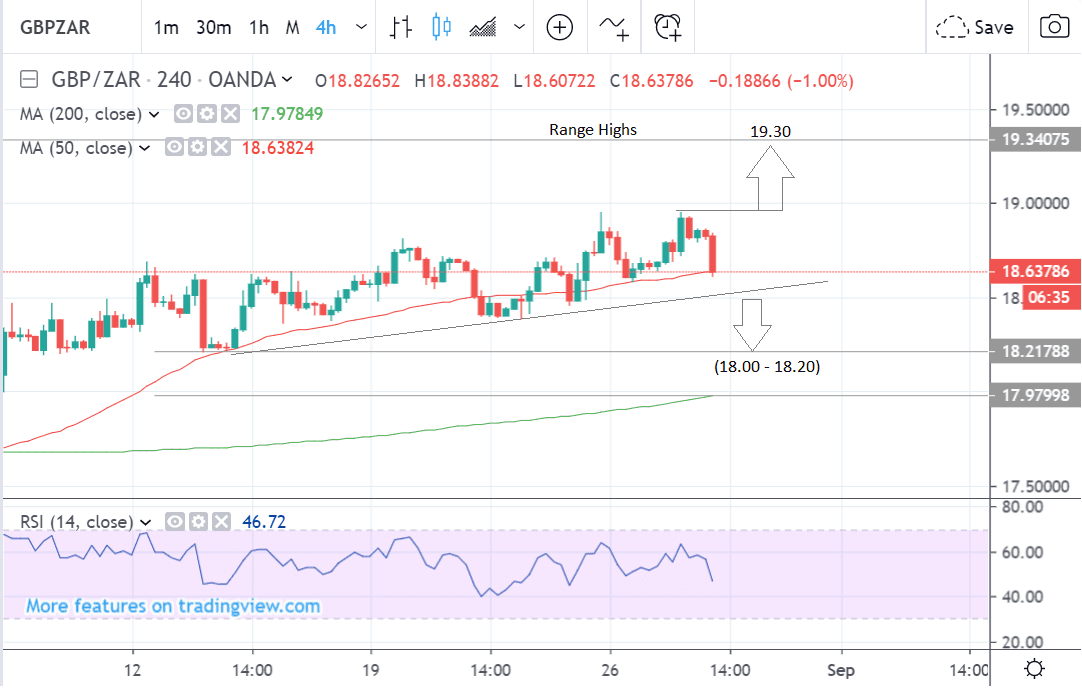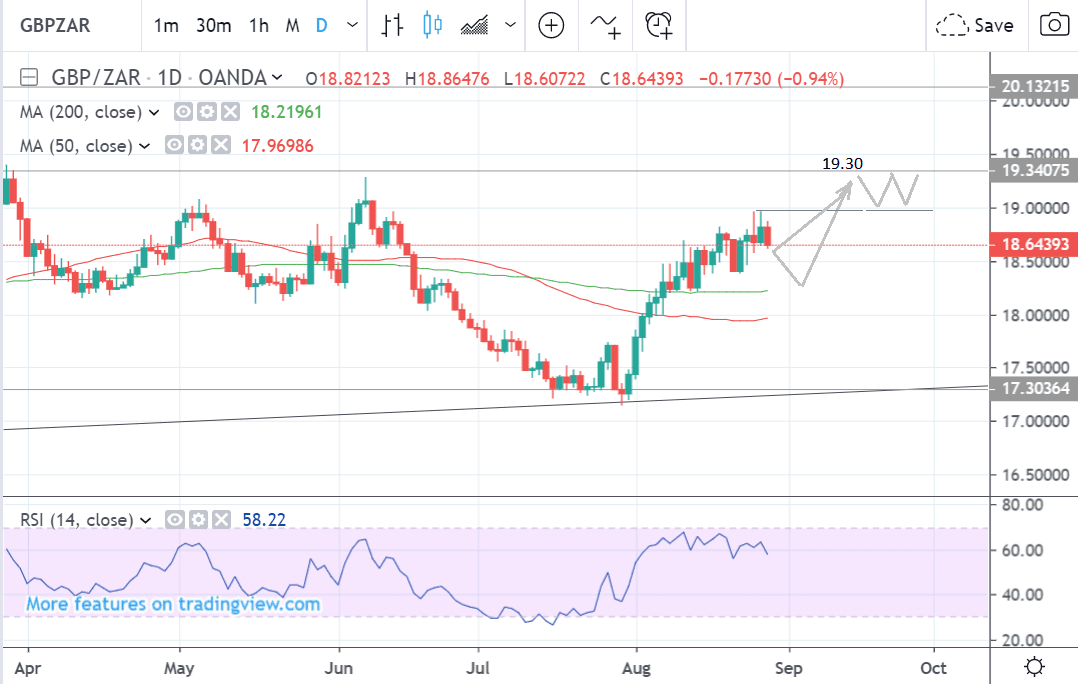Pound-to-South African Rand Outlook: Uptrend Looking Vulnerable, but Still Intact

Image © Adobe Images
- GBP/ZAR’s short-term uptrend to extend
- Risk of a pull-back as recent price action weaker
- Rand to be moved by CPI and global risk appetite
The GBP/ZAR exchange rate is trading at around 18.65 as we reach the middle of the week, almost 0.5% down from the start of the week, but despite the decline, the trend remains bullish and expected to continue higher in the short-term.
The 4hr chart - used to determine the short-term outlook, which includes the coming week or next 5 days - shows the pair rising albeit at a slower rate than before.
The short-term trend is bullish, and given the old adage that ‘the trend is your friend’, it is expected to continue. A break above the 18.95 highs would probably result in a continuation higher to a target at 19.30.
The RSI momentum indicator is failing to rise even though the price is, and this ‘divergence’ is a bearish sign, however.
Taken together with the weakening uptrend overall the chart suggests a risk of a breakdown occurring, with a move below 18.30 leading to a move down to a target in the 18.00 - 18.20 range.
The daily chart shows how the pair has been rising in a short-term uptrend for the whole month of August.
It has successfully broken above both the 50 and 200-day MAs in the early 18s, which would normally be expected to resist further upside, and this has reinforced the uptrend, which is likely to go higher.
The next major target is the 19.30 range highs at which point the pair will probably encounter resistance, pull-back, and go sideways for a while.
The uptrend is losing momentum and there is a risk it could pull-back down to about the level of the 200-day MA before going higher again. A break above the 18.95 highs would, therefore, provide the necessary confirmation for more upside.
The daily chart is used to give us an indication of the outlook for the medium-term, defined as the next week to a month ahead.
The weekly chart - used to give us an indication of the outlook for the long-term, defined as the next few months - shows the multi-month bullish target for the pair probably stands at 20.000 and the August 2018 highs.
Time to move your money? Get 3-5% more currency than your bank would offer by using the services of foreign exchange specialists at RationalFX. A specialist broker can deliver you an exchange rate closer to the real market rate, thereby saving you substantial quantities of currency. Find out more here.
* Advertisement
The South African Rand: Key Drivers to Watch
The most important drivers of the SA Rand in the short-term are likely to be global risk trends and the fluctuations of the U.S. Dollar due to the Rand’s close negative correlation to the U.S. currency; the newly announced reforms recently published by the SA Treasury, may also impact.
Risk trends have stabilised, as there has been little additional news on the trade war front.
U.S. - Chinese trade relations soured after both nations announced they would be increasing existing tariffs last week, and China said it would be charging a 25% tariff on U.S. autos. Markets await the next twist and turn. Any further worsening of the trade war would be expected to weigh on the Rand.
Another driver of risk trends is the Italian political situation, which remains without resolution as M5S and the democratic party continue to engage in talks about forming a coalition. There is a good chance they will eventually announce a coalition deal which will give a small boost to risk assets and the Rand.
Brexit remains a highly uncertain event with opposition forces currently gathering to thwart a potential ‘no-deal’ Brexit and Boris Johnson reportedly preparing to call on the Queen to prorogue Parliament (meaning close it down), so he can decide Brexit without the interference of the commons.
The U.S. Dollar continues to trade quite robustly despite ‘negative treasury yields’ which would normally be expected to weigh on the currency.
Longer-term there is a risk the U.S. Dollar will weaken as it is increasingly being seen as a negative factor in the ‘new abnormal’ of low growth and low yields.
“The strong dollar undermines world trade, damages the balance sheets of international USD debtors, restricts cross-border lending and spreads ‘secular stagnation’ around the globe,” says Dario Perkins, an analyst at TS Lombard.
The need for a weaker Dollar may have prompted French president Macron to suggest the currency should ‘share’ its global reserve currency status more equally with the other major currencies, at the recent G7 summit.
If implemented, such an initiative would weaken the greenback yet it seems far from likely. Such a move would make the U.S. look weak, making it difficult to promote politically.
In the short-term, U.S. Personal Consumption Expenditure (PCE) data out on Friday could impact on the U.S. Dollar and therefore the Rand.
PCE is the favoured inflation gauge of the Federal Reserve, which sets interest rates in the U.S. to which the Dollar is highly sensitive. An unexpected rise in PCE would likely push back expectations of rate cuts in September and support the Dollar; a fall in PCE would cause the opposite.
The Rand is finding support currently from the surprise release of ‘discussion document’ from the SA Treasury outlining a strategy to support economic growth and bring down unemployment.
The discussion document includes 5 broad categories of reform: 1) modernising network industries, 2) supporting small business and fair competition, 3) prioritising labour intensive growth, 4) targeting smart government aid 5) improving regional growth initiatives.
On the domestic hard data front, the July trade balance will also be released on Friday. The trade surplus widened to R4.4bn in June, from R1.7bn in May. The consensus estimate is for it to have increased to R2.9bn in July. Generally, the higher the surplus the better for the currency.
Time to move your money? Get 3-5% more currency than your bank would offer by using the services of foreign exchange specialists at RationalFX. A specialist broker can deliver you an exchange rate closer to the real market rate, thereby saving you substantial quantities of currency. Find out more here.
* Advertisement







